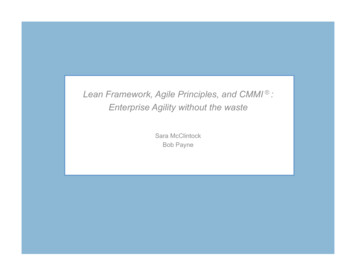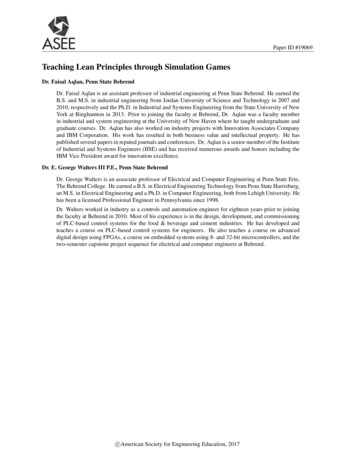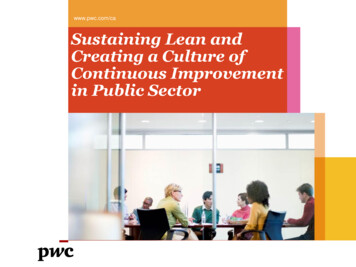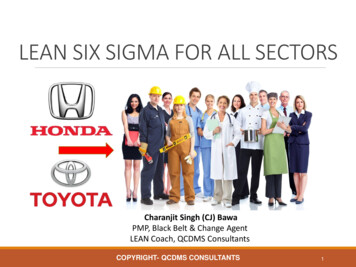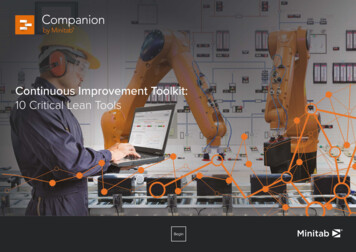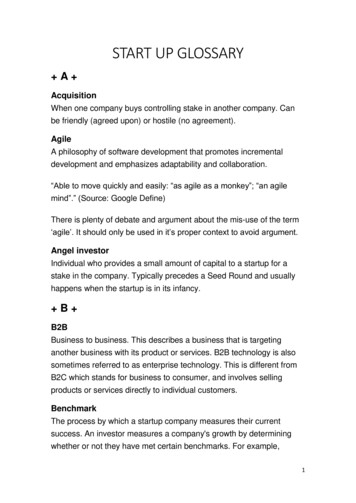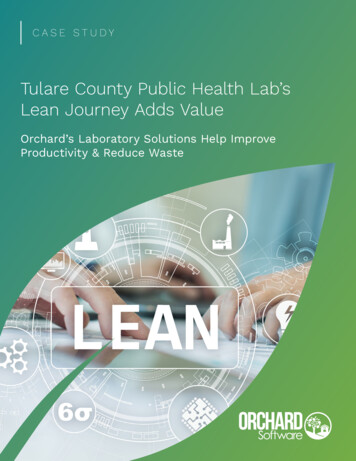
Transcription
609APPLYING LEAN TECHNIQUES IN DELIVERYOF TRANSPORTATION INFRASTRUCTUREPROJECTSAwad S. Hanna1, Michael Wodalski2, and Gary Whited3ABSTRACTThe use of Lean techniques for the delivery of large complex capital projects isquickly growing throughout the country. Lean techniques allow for project delivery inless time, at lower costs, and with improved quality. However, Lean techniques arecurrently not being used by State Highway Agencies (SHA). Lean project deliverycan be the new way for future projects to achieve these higher quality, quicker, andmore efficient projects. To attain this, the transportation industry, as a whole, needsto work closely together using non-traditional approaches to achieve the necessaryimprovement.To reach this goal, this project looks at the benefits of Lean techniques in thedelivery of transportation projects, along with potential impediments to adoption. Thetransportation industry provides a unique challenge in implementing Lean techniquesby being in the public sector. Due to this fact, special care is needed in identifyingany impediments to implementation when going forth with Lean. Once promisingtechniques and impediments are properly identified, a successful management plancan be created to help SHA‘s begin their Lean journey.KEY WORDSLean Construction, Lean techniques, Transportation, Project deliveryINTRODUCTIONLean techniques describe a set of non-traditional project delivery approaches tomanaging the multitude of collaborative relationships that exist on a project.Companies and projects that utilize lean techniques are better able to integratemanagement components. As a result, they are able to deliver high-quality products inless time and at lower costs.Lean techniques first emerged in manufacturing, where Toyota developed arevolutionary set of techniques to minimize waste during automotive production(Liker, 2004). These Lean techniques streamlined the manufacturing process andproved to be effective at production management. Today, Lean techniques are123Professor and Chair, Construction Engineering and Management Program, Department of Civiland Environmental Engineering, University of Wisconsin-Madison, 2320 Engineering Hall, 1415Engineering Drive, Madison, WI 53706, hanna@engr.wisc.eduMS Candidate, Department of Civil and Environmental Engineering, University of WisconsinMadison, 2256 Engineering Hall, 1415 Engineering Drive, Madison, WI 53706,wodalski@wisc.eduProgram Manager, Construction and Materials Support Center, Department of Civil andEnvironmental Engineering, University of Wisconsin-Madison, 2314 Engineering Hall, 1415Engineering Drive, Madison, WI 53706, whited@engr.wisc.eduContrast and Cost Managment
610 Awad S. Hanna, Michael Wodalski, and Gary Whitedsuccessfully used in industries throughout the world. Lean techniques are beingadopted by the construction industry and are currently used in general constructionand other non-transportation projects throughout the United States.―Lean techniques‖ is a broad term that encompasses a variety of tools, strategiesand technologies. Taken as a whole, Lean techniques provide continuous assistanceand support at all stages of the project. During the design and development process,Lean techniques result in an increased quality of design through constructability anddesign reviews. During construction, Lean techniques enhance collaboration betweenproject parties and foster a culture of continuous improvement. Projects that utilizeLean techniques can be completed in less time and with fewer costs than typicallyrequired.Lean techniques improve work flow and productivity by systematicallyidentifying and minimizing waste. Waste is defined here as activities that do not addvalue to the project. When implemented, Lean techniques can produce the followingresults: The facility and its construction processes are designed together to betterachieve customer needs. Construction activities are structured to remove obstacles so that work is readyto be done when it needs to be done. Waste is reduced because work flow is more predictable and productivityimproves. Management efforts are aimed at improving total construction projectperformance rather than focusing on the speed of any one activity. Project control focuses on ―making things happen‖ rather than ―monitoringresults‖. The project team‘s owners, designers, contractors and suppliers are linkedtogether with common goals and a planning system.Transportation agencies have implemented different project delivery systems toachieve some of these same goals. Traditionally, State Highway Agencies (SHA) usethe design-bid-build (DBB) project delivery method to complete transportationinfrastructure projects. DBB requires that the owner first contract with a design entityfor complete design documents. Once the design is complete, the owner then solicitsbids from contractors to perform the work. The owner then selects a contractor basedon their bid. Other commonly used delivery methods include Construction Managerat Risk (CM at Risk) and Design-Build (DB) (Konchar and Sanvido, 1999)Lean techniques foster a fundamentally different approach to project delivery.Lean project delivery involves using Lean techniques to increase levels of integrationand cooperation on construction projects while improving quality, shortening projectduration and reducing costs. Table 1 shows a comparison between the traditionalproject delivery methods used in transportation projects and lean project delivery.Proceedings IGLC-18, July 2010, Technion, Haifa, Israel
Applying Lean Techniques in Delivery of TransportationInfrastructure Projects611Table 1: Project Delivery Systems (DE Design Engineer, SHA State HighwayAgency, PC Prime Contractor, CM Construction Manager) (Format from Boldt,2009)Design-BidBuildCM at RiskDesign-BuildLean tionContractsHeld By:ChangeOrders:CollaborationProjectScheduleSHA hasseparatecontracts withDE and PC.PC selectssubcontractorsSHA hasseparate contractwith DE andCM/PC.CM/PC thencontracts withsubcontractors.SHA contractswithDesign/BuildTeam, whothen designsand constructsthe facility.OwnerCM At RiskDesign-BuilderIncreased riskdue to the bidenvironmentusing thelowestacceptable bidReducedbecause ofincreased totalteamcollaborationduring designphaseRisk is directlyrelated totiming of costsbeing locked inLimitedbecause designis completebeforeselection ofPCEarly selectionof CM providesfor improvedcollaborationLinear projectschedulewithout anyoverlap ofproject phasesFast-trackSchedule withemphasis on upfront planning toaccelerategroundbreakingand completionCollaborationwith the DBteam ismaximized, butSHA has lessinvolvementFast-trackSchedule withemphasis onup-frontplanning toaccelerategroundbreakingand completionSHA, DE, CM, PCand key tradespartners are partyto single contract;additionalconstruction anddesign partners jointhe team throughJoiningAgreements to theContractCore group ofintegrated teamShould be kept to aminimum becauseof high degree oftotal teamcollaborationduring designphase.Maximumcollaborationbecause of contractstructure; colocation of entireteam is possible.Similar to DesignBuild, but theproject team hasgreater control overthe scheduleLean project delivery results in all parties being subject to a single contract where riskis shared and collaboration is required. Future transportation infrastructure projectsContrast and Cost Managment
612 Awad S. Hanna, Michael Wodalski, and Gary Whitedwill need to look to the lean approach to ensure greater quality, lower costs andquicker time to market.LEAN TECHNIQUES IN THE TRANSPORTATION INDUSTRYConstruction of new infrastructure projects is a major cause of traffic bottlenecks. It iscritical that the addition of new infrastructure or the repair/replacement of existingprojects be completed as quickly as possible. Projects must be long-lasting andcompleted with minimal disruption to the community. According to their currentmantra, SHAs must ―get in, get out, and stay out‖.Lean techniques are a way for future projects to achieve these goals. Rapid oraccelerated projects typically involve complex logistical requirements, unique designsand difficult construction conditions in which Lean techniques are ideal.Using Lean techniques, future projects can be completed faster, more efficientlyand with higher quality. The transportation industry, SHAs, contractors andconsulting engineers must work together using non-traditional approaches, such asLean techniques, to produce the necessary improvements in transportationinfrastructure.CHALLENGES OF LEAN CONSTRUCTION IN PUBLIC SETTINGThe benefits of Lean techniques are well-documented in many industries, rangingfrom manufacturing to construction. However, public transportation projects presentparticular challenges to the implementation of lean techniques. Listed below are themost common barriers to implementing an Integrated Lean Project Delivery (ILPD)that an owner may face.LEGAL ISSUESFor public construction contracts, there are often restrictive laws governing theselection of contractors. In particular, low-bid competitive bidding is often mandatedor strongly suggested. This creates a challenge when implementing a Lean projectdelivery system.Lean relies on the careful selection of contractors andsubcontractors, which conflicts with several of the characteristics of a competitivebidding process. With Lean, contractors are selected early in the project cycle,allowing for strong collaboration between project parties from the design stageonward. This is at odds with traditional bid award processes that require that thedesign be completed for bidders to evaluate. Furthermore, a Lean project deliverysystem selects the ―best‖ contractor for the project, while competitive bidding selectscontractors according to the lowest bid.The relevant laws vary from state to state; however, there is often a plethora oflaws governing the selection of contractors, subcontractors and design professions.These legal issues must be investigated and adequately resolved before an effectiveLean project delivery system may be implemented.FEAR OF CHANGESince the start of the modern construction era, the main delivery system has beendesign-bid-build. Until the last few decades, it was essentially the only deliverysystem (Federal Highway Administration, 2006). The working and managementProceedings IGLC-18, July 2010, Technion, Haifa, Israel
Applying Lean Techniques in Delivery of TransportationInfrastructure Projects613philosophies of SHAs were designed to complete projects using the DBB deliverysystem.Leadership and training is needed to overcome the fear of change. In a surveyresponse concerning innovative delivery systems, the Minnesota Department ofTransportation wrote:―With any organization, culture changes need to occur with any shifts indelivery or modifications in a system. With an organization as large as aDOT, perceptions of change are going to vary greatly (i.e. some people arewilling to accept new ideas, others are not). With any change, champions areneeded to implement new technology and practices.‖(Hanna et al, 2008)Detailed training on the system of Lean project delivery is an effective way tofamiliarize staff with the new delivery method processes.LACK OF RESOURCESIn most cases, an organization will initially lack some of the resources to successfullyimplement a new delivery system. Resources may include budget, knowledge andexperience.Knowledge and experience is gained over time, as Lean techniques are applied tomore projects.Formal training and communication with others who haveimplemented Lean techniques can help overcome the ―knowledge gap‖ that may existduring the early Lean projects. Formal training may include university courses,attending Lean workshops or conferences or hiring a consultant with expertise in Leandelivery systems. Communication can occur with anyone involved on a constructionproject that utilizes Lean techniques; many of the lessons learned in other constructionindustries are applicable to transportation infrastructure.RISK MANAGEMENTRisk is an inherent part of the construction industry and is present on every project,Lean or otherwise. Risk management is defined by the Project Management Instituteas ―the art and science of identifying and responding to risk factors throughout the lifeof a project and in the best interests of its objectives.‖ In general, there are threestrategies involved in risk management – eliminating risk, transferring risk, oraccepting risk. The fundamentals of risk management according to the ConstructionIndustry Institute (Hanna, 2007) are as follows: Risks belong with those parties best able to evaluate, control, bear the cost,and benefit from the assumption of risks. Many risks and liabilities are not to be totally assigned but may be shared. Every risk has an associated, unavoidable cost which must be assumed in theplanning, designing, bidding, or construction of the work.LEAN TOOLS AND TECHNIQUESMany Lean techniques have been successfully used in non-transportation projects.Through the research the team has identified those techniques that can be used on anyproject independent of delivery type. These techniques include but are not limited to:Contrast and Cost Managment
614 Awad S. Hanna, Michael Wodalski, and Gary Whited Value-stream mapping Supply chain management Just-In-Time Delivery Last PlannerTM concept ―culture‖ 6 sigmaEach technique is summarized below, along with information on how they may beimplemented to improve the construction process.VALUE-STREAM MAPPINGValue stream mapping (VSM) is a Lean technique used to improve existing workactivities or processes. The purpose of VSM is to ensure that each process or activityadds value to the project. It involves analyzing a process or activity, identifyingproblem areas, and then creating an improved plan, known as a future state map, forthat process.The future state map shows the ideal steps in completing a process in the mostefficient way possible. The future state map may improve on the current process byeliminating double handling, excess materials, obtaining information more quickly,etc, and functions as a goal for the team to works towards (Rother and Shook, 2009).The value stream map is used eliminate or minimize the non-value addingactivities which allows the process to be streamlined. This helps to reduce the cycletime of the process and allows for everyone involved to have a better understanding ofwhat activities are involved in a process.SUPPLY CHAIN MANAGEMENTSupply chain management views product production as a joint, coordinated effortbetween a network of interconnected businesses (Harland, 1996). On any project,multiple suppliers of services and materials are all involved in producing the finishedproduct. Supply chain management is a system for coordinating and managing thecomplex logistics within a project.Supply chain management may be divided into five categories or businessprocesses: planning, procurement, production, distribution and customer interface.Supply chain management views the relationships between suppliers, vendors andcustomers as a holistic system. Improvements in one area can create a ―ripple effect‖,causing positive change throughout the system.To effectively use your supply chain management on a construction project it mayhelp to first create a value stream map. This will help to identify where and wheneach product needs to be delivered. It is then up to the management team to workwith the appropriate suppliers to ensure that the necessary supplies will be available.This concept is closely tied to the Just-In-Time (JIT) delivery technique.JUST-IN-TIME DELIVERYJust-in-time delivery is an inventory strategy that reduces in-process inventory andreduces carrying costs. Materials are delivered when they are needed, rather thanProceedings IGLC-18, July 2010, Technion, Haifa, Israel
Applying Lean Techniques in Delivery of TransportationInfrastructure Projects615being stockpiled on site. This minimizes double handling, reducing the chance ofmisplaced or damaged materials and cuts back on storage costs and set-up times.Just-in-time delivery has particular application to sites where there is very littlespace for on-site storage or where theft and weather damage of materials are aproblem. This concept must be integrated with supply chain management to ensurethat the necessary materials are delivered on time. Detailed planning and coordinationare required to implement a just-in-time delivery system, as any delay in deliveriescan affect the operations of the entire project.Just-in-time delivery is essential in creating a productive construction site becauseif the correct tools and materials are not available, there will be excess waiting on siteas well as any excess of movement due to mobilizing to a part of the site that is readyto be worked on. In order to know when and where these deliveries take place, a toolsuch as the Last PlannerTM should be used.LAST PLANNER CONCEPT “CULTURE”The Last PlannerTM concept culture is a collaborative method of scheduling workactivities. In traditional scheduling practices, the person who makes the schedule isseparate from the person who completes the work. Last PlannerTM combines theseroles, ensuring that the person with the greatest ability to complete an activity is alsoresponsible for setting the corresponding schedule.The Last PlannerTM is the person who has the most control over an activity andknows best when the task will be completed (Ballard, 2000). Last Planners areassigned responsibility for the tasks they directly control, which creates accountabilitywithin the system. Group meetings at the end of the week allow people to presenttheir needs to the other team members, fostering collaboration. These meetings allowfor schedule constraints and conflicts to be proactively identified and resolved. Thisalso allows for specific delivery dates to be identified so that the necessary suppliesare onsite only when needed.Last PlannerTM concept culture results in cost savings by streamlining thescheduling process. Reliable commitments allow for work to be completedsequentially during the project, increasing productivity and reducing float anduncertainty. These processes can be monitored using a Six Sigma approach in orderto keep processes in statistical control.SIX SIGMA (6σ)Six Sigma (6σ) is a business management strategy, originally developed by Motorola,focusing on quality control. Six Sigma improves quality by identifying and removingthe causes of defects and variability in the production process (Antony, 2008).To achieve Six Sigma, a process must produce no more than 3.4 defects permillion opportunities. Six Sigma defines a defect as anything outside of consumerspecifications. The Six Sigma approach to reducing defects varies depending onwhether the process is new or already established.For already established projects, the DMAIC methodology is used. DMAIC standsfor Define, Measure, Analyze, Improve and Control. Define project goals and the current process. Measure key aspect of the current process and collect relevant data.Contrast and Cost Managment
616 Awad S. Hanna, Michael Wodalski, and Gary Whited Analyze the data to determine relationships and identify relevant factors.Improve or optimized the process based upon data analysis.Control to ensure that any deviations from the target are corrected before theyresults in defects.For projects aimed at creating new products or designs, the DMADV methodology isused. DMADV stands for Define, Measure, Analyze, Design and Verify. Define design goals that are consistent with customer demands and theenterprise strategy. Measure and identify CTQs (characteristics that are Critical To Quality),product capabilities, production process capability and risks. Analyze to develop and design alternatives, create a high-level design andevaluate design capability to select the best design. Design details, optimize the design, and plan for design verification. Verify the design, set up pilot runs, implement the production process andhand it over to the process owners.Six Sigma is related to, but distinct from Lean manufacturing. Lean can be seen asa proactive approach to project management, while Six Sigma is a reactive approach,specialized for quality control. The system produces cost savings by controlling andimproving the quality of work completed on site. An example of how Six Sigma andLean can be joined on a public transportation project is described in the followingcase study.MOTORWAY CASE STUDY4In October 2006, work began on the Albanian Motorway Project under a fixed unitrate contract with the Albanian Government. For the project Bechtel is constructing a61km motorway which includes a 5.5km twin bore tunnel (Bechtel Corporation,2008). This was the largest project ever undertaken in Albania and the re-election ofthe Government at the time was in part dependent on the successful opening of theproject by June 2009.During construction Bechtel discovered that the quality of rock in the tunnel wassignificantly worse than the quality stated in the plans. This finding created an initialschedule delay of five months due to the fact that productivity was slower in thepoorer rock grade (from class II to class IV) and because the critical path of theschedule went through the tunnelling process it was known that any delay intunnelling would delay the project. However, due to the high profile nature of theproject Bechtel knew that they had to have the tunnel open by June 2009.THE IMPROVEMENT PROCESSInitially, Bechtel was expecting class II rock which they would have been able toexcavate at 5.55m/day, whereas productivity in the class IV rock was initially at3.07m/day. In order to complete the project on time, Bechtel implemented a StrategicGap Analysis on the tunnelling process to identify where improvement efforts shouldbe focused.4Information for the Motorway Case study is from (Silby, 2010) and (Bechtel Corporation, 2008)Proceedings IGLC-18, July 2010, Technion, Haifa, Israel
Applying Lean Techniques in Delivery of TransportationInfrastructure Projects617The team started by conducting a process map of the tunnelling cycle. The mapallowed the team to identify all of the necessary steps in completing the process aswell as identify how long each process took. From the process map and conducting aPareto analysis, the team found that the three processes with the longest cycle timeswere the shotcrete, drilling, and mucking operations.For the shotcrete placement, the process improvement team walked through theprocess and used a fishbone diagram to identify forms of waste and improvementareas. An example is that there was excessive waiting in the process due to delayswith mixer truck arrival times. This is a step that could use a Lean technique, forexample supply chain management linked with JIT delivery in order to coordinate themixer trucks on site better for arrival accuracy. By working through the shotcretecycle, the process was improved by 30 minutes which improved the process by 18%.The drilling process had the second highest cycle time. This process wasimproved from an average of 98 minutes down to 85 minutes. An example ofimprovement was the addition of an extra drilling jumbo to ensure that a spare wasavailable at all times. It was found that the cost for the additional equipment wasminimal compared to the benefits of the time saved. By looking at a mapped outprocess and understanding where the bottleneck may be, such as the case withdowntime in the drilling process, it is easier to identify which activities are critical tothe process productivity.The third process analyzed was the mucking away process. There was significantwaste in waiting time as the loader had to wait for trucks, due to the space constraintsof the tunnel. A time motion study was used in order to optimize the process.Through traffic management improvements it was found that continuous productivitycould be achieved. Additional side mucking was used where the spoil material wasspread along the side of the tunnel away from the face which allowed the next processstep to begin immediately. These improvements led a 14% (23 minute) reduction inmucking cycle time.Through these improvement processes as well as others the team was able toimprove the tunnelling productivity by 43% (3.07m/day to 4.45m/day) in type IVrock. As seen in just these three processes almost one hour was eliminated from thetunnelling process. Through these improvements there was a hard savings of 21million and reduced the potential five month extension down to zero. This resulted inthe tunnel opening in time and created new tunnelling processes which will be used infuture tunnel work.CONCLUSIONThe improvement processes used in the case study show the effect that Leantechniques can have on a public transportation project. This was a project that had afixed rate unit contract and did not have a special integrated delivery method. Itshowed that many of the Lean techniques being used today can be implemented if thecontractor is willing to take the time and make the effort. This project in particularhad a set finish date with possible serious consequences if the motorway was not openon time. Thus, moving forward the first projects to implement these techniques maybe those that have a tight schedule and need to complete a project in the allotted timewith the most efficient processes.Contrast and Cost Managment
618 Awad S. Hanna, Michael Wodalski, and Gary WhitedWhen looking at the obstacles to implementing a Lean project many obstacles arerelated to the contractual obligations. By creating an in-house improvement process,it is possible to improve projects with the current delivery methods. This can help toalleviate any legal issues that may come up. Companies should find that improvingproductivity improves profits and this will help mitigate the fear of any change inproject management. The more projects that are completed and utilize these tools themore individuals will learn the techniques and be able to spread the knowledge.With these principles in place and with continuous improvement in mind, industrywide productivity should pick up as more and more contractors begin to utilize theseLean techniques. Construction productivity will therefore start to mirror theproductivity increase as seen in other industries.FURTHER RESEARCH NEEDEDWhile there are many positive examples of using Lean techniques in manufacturingand private building construction, transferring those same concepts to publicly ownedtransportation infrastructure projects will be difficult. The institutional, cultural andlegal barriers are sizeable, thus future research is planned to identify tools andtechniques that are currently being successfully used in delivery of transportationprojects, such as Partnering, that are similar to those used in Lean project delivery toease the cultural fear of implementing Lean concepts. Research is underway toidentify the barriers that exist for SHA‘s to implement the most commonly used Leantools for both traditional design-bid-build and design-build procurement methods andhow these can best be overcome. Research also needs to be done through worksampling studies to identify sources of waste and non-value adding activities, whichcan be directly applied to Value Stream Mapping techniques to improve the deliverytime for transportation construction projects. Results of this and similar research willgreatly speed up the adoption of Lean techniques by State Highway Agencies,contractors, and consultants involved in the delivery of transportation projects.REFERENCESAntony, J. (2008) "Pros and cons of Six Sigma: an academic perspective".http://www.onesixsigma.com/node/7630. (May 1, 2008)Ballard, G. (2000) ―The Last Planner System of Production Control.‖ PhDdissertation, Dept. of Civil Engineering, University of Birmingham, UK.Bechtel Corporation (2008) ―Albanian Motorway Project‖ December 2008. InternalReportBoldt (2009) ―Comparison of Project Delivery Methods‖ February 2009. InternalDocumentFederal Highway Administration (2006). ―Design-build Effectiveness Study,‖ FinalReport, build0.htm (June 21, 2007).Hanna, A. S. (2007) ―Contracting to Appropriately Allocate Risk.‖ Report 210-11.The Construction Industry Institute. December 2007.Hanna, A. S., Lynch, J. C. and El Asmar, M. (2008) ―Effective Implementation of theDesign Build Project Delivery System on Transportation Projects. Submitted tothe Midwest Regional University Transportatoin Center.Proceedings IGLC-18, July 2010, Technion, Haifa, Israel
Applying Lean Techniques in Delivery of TransportationInfrastructure Projects619Harland, C.M. (1996) ―Supply Chain Management, Purchasing and SupplyManagement, Logistics, Vertical Integration, Materials Management and SupplyChain Dynamics.‖ In: Slack, N (ed.) Blackwell Encyclopedic Dictionary ofOperations Management. UK: Blackwell.Konchar, M., and Sanvido, V. (1999). ―Comparison of US Project Delivery Systems,‖ASCE, Journal of Construction Engineering and Management, 124 (6), 435-444.Liker, J. (2004) The Toyota Way New York, McGraw-HillRother, M. and Shook, J. (2009) Learning to See Cambridge, The Lean EnterpriseInstituteSilby, M. (2010). Bechtel Six Sigma Corporate Deployment Champion. TelephoneInterviews, June, 2010.Contrast and Cost Managment
Lean project delivery involves using Lean techniques to increase levels of integration and cooperation on construction projects while improving quality, shortening project duration and reducing costs. Table 1 shows a comparison between the traditional project delivery methods used in transportation projects and lean project delivery.
